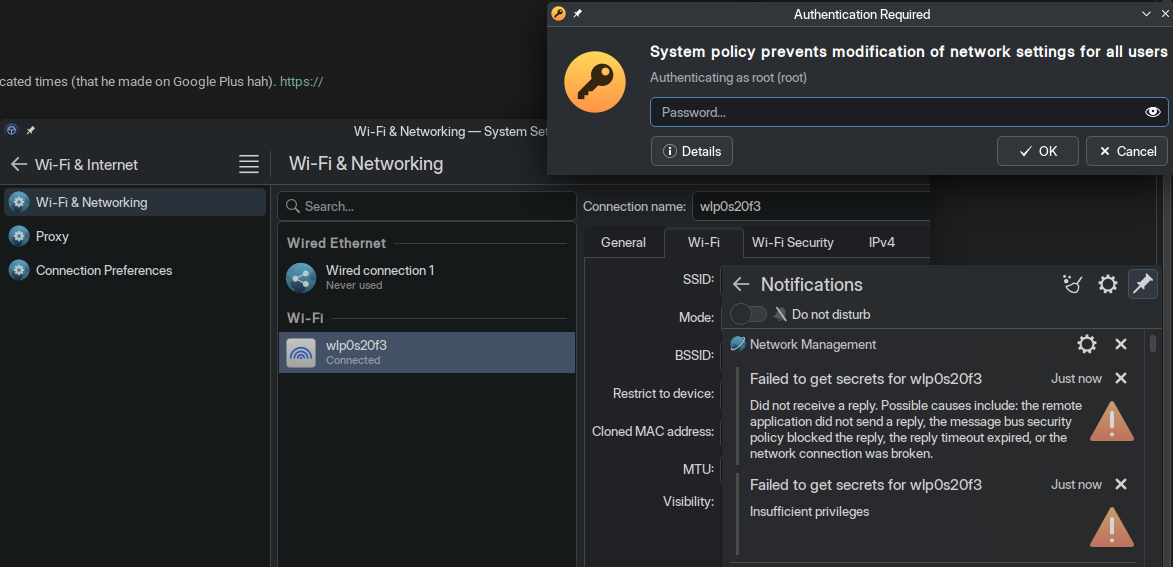Any recommendations for a linux distro that i can set up and be reasonably sure my non techy SO won’t break accidentally? The set up doesn’t have to be easy it just has to not break once I leave her alone with it. My first thought was popOS.
My plan is to have 2 profiles and not give her access to sudo. I just don’t want to have to go into it unless she needs a new program.
Fedora Atomic desktops, specifically Kinoite with KDE6 works well for me, and is basically unbreakable due to the way it works.
I vote the same, but I’d suggest a uBlue spin of the Fedora Atomic desktops. They have better defaults (all batteries included, as they say) and are easier to use overall IMHO. Bluefin and Bazzite are both great options, and both offer KDE and Gnome variants.
Edit: TIL the KDE version of Bluefin is called Aurora.
BTW, uBlue is getting some big recognition lately. They have been on the Fedora Podcast (official) and Framework Laptops has official instructions on their website for installing Bluefin and Bazzite.
Gotta be slightly careful with those spins though because there is near-zero documentation.
They have significant documentation, and anything not covered here is just part of Fedora atomic:
That is a different spin than the original comment, which is why I made that commen.
https://docs.getaurora.dev/ https://docs.projectbluefin.io/ aurora has one small page of documentation total unless you click on the logo which suddenly opens a hidden unlabeled drawer with sparse docs. Bluefin has even less. I consider this near-zero documentation. So how would OP’s non-techy girlfriend (or someone who has only heard of aurora and bluefin from this thread) know to go to bazzite, a completely different project to most people, to debug their completely different OS? Because googling “ublue aurora flatpak won’t install” literally gives this page: https://docs.getaurora.dev/guides/software/ which is literally almost useless.
Bazzite’s documentation has gotten way better since I installed it (they had almost nothing on rpmostree commands when I did), but I don’t believe everything in the documentation for bazzite applies the same to aurora and bluefin, especially with differences in pre-installed non-layered gaming defaults vs working with flatpaks will be not even close to the same.
Also fedora knoite has little documentation https://docs.fedoraproject.org/en-US/fedora-kinoite/. It has enough to get you started and installed, but that is about it. It has one single line of code about
rpmostreefor example, not even anything about installing an RPM not in fedora’s limited repos.I didn’t say any of it was bad. Just that you have to be slightly careful with using those for non-techy users because the documentation just isn’t there yet.
Bluefin has even less. I consider this near-zero documentation.
What do you feel is missing from the documentation, can you be specific? You’re examples are too generalized to be actionable.
Fedora is a bit too eager to deliver new updates IMO, especially KDE. As much as I love KDE, their .0 releases have had serious bugs several times in a row now. It’s always better to wait for .1 patch with Plasma. It may be hard for the user to break Kinoite, but it won’t save them from bugs.
Fedora’s mission have always been to push new stuff when it’s “mostly ready” at the cost of inconveniencing of some users, so I wouldn’t recommend it for non-tech-savvy people.
I know people say that it’s 100% stable for them (as they do for Arch, Tumbleweed, Debian Sid, etc) but that’s survirorship bias. As any bleeding edge distro, Fedora has its periods of stability that are broken by tumultuous transitions to the new and shiny tech (like it was with Pipewire, Wayland default, major DE upgrades, etc). During these times some people’s setup will break and you don’t know ahead of time if it will be yours.
Pick one of the
stablechannels from Universal Blue. You get the Fedora atomic goodness, but “ready” rather than “mostly ready”.Does it use the same flawed approach as Manjaro by indiscriminately delaying all updates (including critical security fixes)?
It would be whatever Fedora is doing in stable, but that seems unlikely. I’m sure the internet has the answer.
I’ve been on the
latestbranch for a year and it’s been rock solid across 2 different laptops.I don’t think Fedora has a “stable” channel. It has “testing” repo from which updates are pushed to “updates” repo after approval, and that’s it. My understanding is that ublue’s “latest” channel follows Fedora’s “updates”, while “stable” seems to update weekly (though it’s unclear what happens if a package update arrives in Fedora just before “stable” image is about to be built)
eh, gnome is about the same.
i always wait for at least the .1 or .2
Haven’t used GNOME for a while, but I guess that’s a problem of open source projects in general. Though GNOME at least has Red Hat behind it.
Linux mint is a good, “click first” distro that won’t break without root + will be easy for her to use. For something with a more modern desktop and more recent updates, Bazzite is really good at just working and (in my experience) has never broken
Bazzite might be what i go for the more i look at it. Thanks
I like bazzite!
Here’s the bazzite attempt at viral marketing, everyone.
Remember when we saw it for MX Linux?
Be careful about what you install on your computers.
Edit: The incessant, vehement backlash against calling out shilling is always a telltale sign of shilling. Shills are not allowed to let people accuse them of shilling without going through their playbook of what to say next.
I mean it’s not perfect but what is?
I tried MX Linux for a while, it was okay. did I miss something?
I tried mx for 7 minutes. it installed nvidia drivers and that killed it. off to the next distro I hopped, knowing the problem could have been easy to fix. shame, it seemed interesting.
I never mentioned perfection.
I hope people reading this can start to recognize shilling when they see it.
Dude you might be paranoid…
Nah. I just wasn’t born yesterday.
“Someone mentions a distro they like” ≠ shilling. I use Bazzite and have been for months. Before that, used Nobara, EndeavourOS, and vanilla Fedora, along with a number of others I tried when I was distro-hopping. Wholeheartedly believe that Bazzite is currently the best generally-available Linux distro for gaming and is up there for general use. It’s not perfect, but nothing is - it gets close for the use-cases I mentioned, though.
Bro I’m the lead developer and I’m just now seeing this, just accept you called the viral marketing wrong.
We’ve grown to the point that when I market something, I tell people not to listen to me because I’m biased.
You know the build scripts which turn Fedora Kinoite into Bazzite are all open on GitHub, right… 🤦
Its popular rnow because of all the handhelds I think
I have tried most known distros but not bazzite, yet. might be the next one on my distrohop journey since everyone recommends it. hope it works better than fedora kde, it does not get along with my hardware AT ALL
For me, Mint borked the network after an update. I never got to figure what was wrong - the local network worked, the Internet connection was there and other devices worked through the same router, remote IPs were unreachable so it’s not a DNS problem, etc.
But I might have had an edge case.
deleted by creator
Any of them. Just don’t give the root password.
This is what I do with my mom and her boyfriend. I’ve had them on Linux for a few years now and neither have managed to break anything.
Might end up in dumb annoying situations like setting up wifi requiring root and such
That is not a thing in userspace. No idea what you’re even alluding to here.

Surprising amount of stuff requires root (or used to). It reminds me of this glorious rant from Linus from his less domesticated times (that he made on Google Plus hah). https://forums.freebsd.org/threads/linus-to-opensuse-devs-kill-yourself-now.30414/
The highlight:
So here’s a plea: if you have anything to do with security in a distro, and think that my kids (replace “my kids” with “sales people on the road” if you think your main customers are businesses) need to have the root password to access some wireless network, or to be able to print out a paper, or to change the date-and-time settings, please just kill yourself now. The world will be a better place.
Oof.
This is old as hell, and on a locked down account. You don’t need restrictions like this for a personal use machine, and a base install of any distro wouldn’t have this type of issue whatsoever. It is not a modern concern.
Friend, this is from my own system I’m running right now lol.
Oh wild, I thought “No way!”, but apparently yes way as I (Tumbleweed/KDE/Standard User) get all of this which I imagine would be disorienting to non-Linux users. Just going to Wi-Fi & Networking, not attempting to make any changes even.

Don’t have this issue on archlinux. I think there is a group, which if you are part of, you can change networking settings.
[moonpie@cachyos-x8664 ~]$ groups moonpie sys network wheel audio kvm lp storage video users rfkill libvirt docker moonpie
Then your account is not part of the proper groups to control NetworkManager as integrated in Gnome. That’s on you.
Friend, that’s KDE lol.
Set up Tailscale and an SSH key for remote tech support
Or just wireguard and ssh?
If you already have a public facing server for them to connect to then sure.
deleted by creator
Or just ssh. Personally I’d set up a remote desktop in addition to that
Aurora by Universal Blue. She will be unable to break it, and it’s so freaking easy to use and install.
While I enjoy using Aurora, there were a bunch of issues popping up over the last few months (e.g. display freezes). I guess that’s the danger of a rolling release cycle, but I’m not sure it’s 100% as foolproof as it needs to be right now.
Aurora is not a rolling release. It’s part of Universal Blue, based on Fedora Silverblue.
Okay, let’s call it a semi-rolling release. Having breaking changes every 6 months is still very often for a set-and-forget system.
Depends on the use case. For example, I actually managed to bork Aurora to the unbootable state while trying to make a VPN work properly a while ago. It didn’t live long :D
I’m gonna be the boring guy.
RedHat Enterprise Linux. (Or Rocky)
Most boring distro ever. Install it, turn on all the auto updates and be happy. Install something to take backups. Ignore any new major-releases, that laptop will die before the OS hits EOL.
Benefits:
- Boring. It’s their tool, not your plaything.
- Actually works
- Will be reasonably secure over time with minimal effort and manual intervention.
- If any commercial Linux software is required, it will most likely only be supported on RHEL or Ubuntu.
- Provides web browser and word-processing. And we don’t need anything else.
Drawbacks:
- Boring (for you)
- Not ideal for gaming
If you install anything else than RHEL-derivatives or possibly Ubuntu on a machine that someone else will use, you are both in for a world of pain. It has to ”just work” without intervention by you, and it needs to keep working that way for the next 5 years.
Source: Professionally deploying and supporting multiuser desktop Linux to a few thousand users other than myself.
In the era of Flatpak, I kind of agree with you.
The primary drawback is the complete lack of packages. A home user is going to want something not included and then things fall apart. Flatpaks and Distrobox have made that a lot better.
If you could get away with a RHEL core and Flatpak for apps, you would have a pretty solid setup for a “normal” person.
I both agree with you, and kinda disagree.
If you venture into installing Flatpaks on such a system, just keep in mind that:
- Auto updates must be on
- The Maintainer of the Flatpak in question must be expected to provide security updates for the next five years or so. Personally, I’d only use it for packages provided directly by project maintainers (i.e. Dropbox from Dropbox Inc. as packaged by Dropbox Inc.).
Keep in mind, like 95% of normal people (we are not normal) don’t know what a package manager is and only use
- ”The internet”
- Webmail
- Google Docs
- Spotify
For that, we need the default desktop install and the Spotify app (probably a Flatpak). That’s about it. It’s a glorified web browser with batteries. Treat it that way and keep it that way, unless your SO has any specific needs and requirements.
The limited and dated package set is kind of a feature. Only packages that should work until the laptop breaks, and only packages that won’t change randomly when you update (mostly).
Really seems like we are agreeing. I get that the limited package set is a feature. I also get that it is both too small and too enterprise to satisfy most people you would describe as a “SO” precisely because they are probably normal people.
You gave the excellent example of Spotify and suggested a Flatpak for that. Honestly, I am not sure where we are in disagreement. Especially since I started by “mostly agreeing” myself. We even agree on that. :)
Mint.
I have my mum (67) and my partner using it.
Libre office and Firefox cover 99.9% of all the things mum actually does.
My partner uses blender, krita and audacity also.
Auto updates… Almost no tech support.
Linux mint makes sense. Auto updates and its hastle free for non techy person like me.
Even if I’m doing something crazy , chatgpt to the rescue.
Use Bluefin or some other immutable/atomic distro.
The upside is that it’s rock solid and will likely never fail in a way that cant be easily rolled back. The downside being that it’s slightly more complex to administer than a traditional distro model (which probably isn’t a big problem if you are going to be administering your SO’s PC for the most part.)
Bluefin is basically a more general desktop, less gaming-focused version of Bazzite. Bluefin uses Gnome, but there’s also a KDE Plasma version called Aurora.
Since less techy people tend to use more the mouse/touchpad anyways, I would pick a hard-to-mess-with desktop environment like Cinnamon or Gnome. With KDE, XFCE and such you can screw panels really easily if you don’t know what you’re doing.
Slap Debian under it and there you goAn immutable distro would be a good choice. They are distros designed to be more resilient against failure. For a gamer, bazzite is a solid choice; otherwise, silverblue.
Any immutable distro would do I guess
That is, if you have experience running immutable distros yourself and are able to serve as a tech support for them should they ever need it.
A lot is different under the hood, and general Linux knowledge doesn’t always help.
I guess it depends what she does on her pc.
But ignoring that, Mint without sudo. Throw in flatpaks and appimages.
Immutable distros are probably fine too but in my experience they tend to be a bit fussy if you need to change something in the system config.
Ubuntu, always a solid choice for beginners but Gnome shell is a bigger change from windows conpared to Cinamon.
P.S. I have Mint on our TV PC and my SO handdles it without issues.
Aurora or Bluefin would be great, general purpose distros. They’re based on Fedora Kinoite and Silverblue, respectively, so you get that atomic unbreakability with the addition of some handy software and easy, optional scripts via
ujust.I have Bazzite on a laptop specifically for this reason, so if I ever kick the bucket early, they will have a reliable and portable computer.
Aurora gets a vote from me. I set it up for my technically repulsive father, and he gets on just fine with it.
Bazzite does seem like a good option, thanks.
Does she want this?
If so then just set her up exactly what you have so you can easily help when there’s a problem.
If not then get her the computer she actually wants.
It’s a no money and cant run windows 11 situation.
Consider 0patch before you give up on windows. They do good work and it’s real affordable.
No matter what you do, in this circumstance it’s worth keeping that windows partition around.
I do think whatever you use is the right choice though.
E: I looked up the 0patch pricing and you get a year of patches for a bunch of eol versions of windows like 7 and 10 for $25 a year. It’s a good deal I think for people who don’t want to or can’t upgrade to 11, and they beat Microsoft to a bunch of zero day exploits.
I know you said it’s a no money kind of situation but I really think when ten is still a possibility theres two bucks and some change a month in the budget.
Consider 0patch before you give up on windows
Unless there’s a very specific application need, I think the most sensible thing would be to ditch Windows. Better for security, better for privacy, better for the world to increase the mainstreaming of Linux.
Yeah wouldn’t it be nice…
But the most considerate thing for the user is to help them use what they want to use. There’s also a real benefit to keeping ahold of that windows because people often have their own ways of doing things and it may be more expedient to boot back into 10 than to figure out how to complete some task in Linux.
Aren’t there ways to patch the whatever-it-is that is “required” by W11 that older PCs don’t have so that you can bypass the check and have W11 on older machines? I feel like that’s a better solution than paying for Microsoft’s garbage, if one was bent on not moving to Linux
I suggested 0patch not to bypass some arbitrary check, for which there are many options, but to provide access to security patches and updates after Microsoft stops publishing them for 10.
Any of the ostree variants of Fedora, be they Fedora Official or downstream ones like the Universal Blue family









